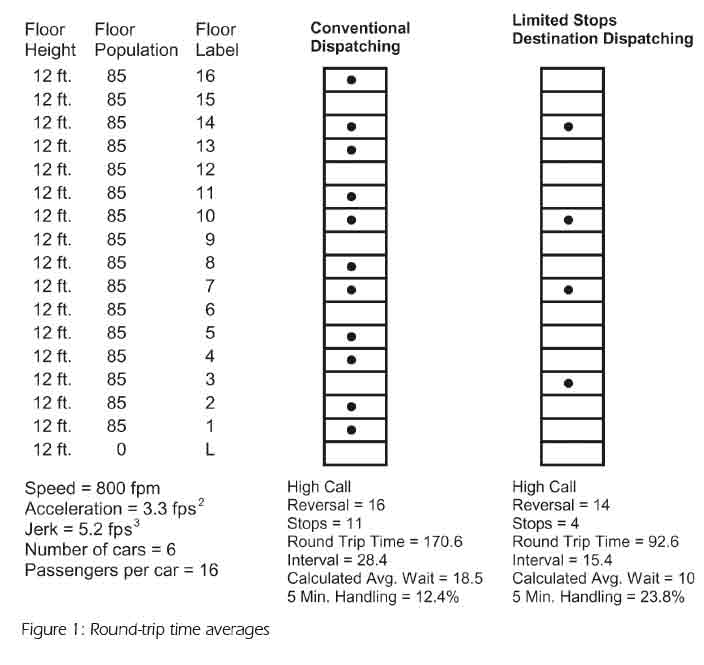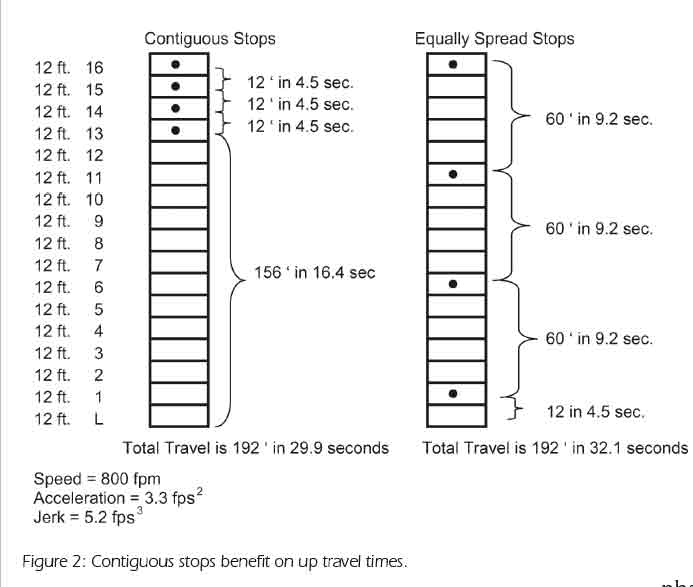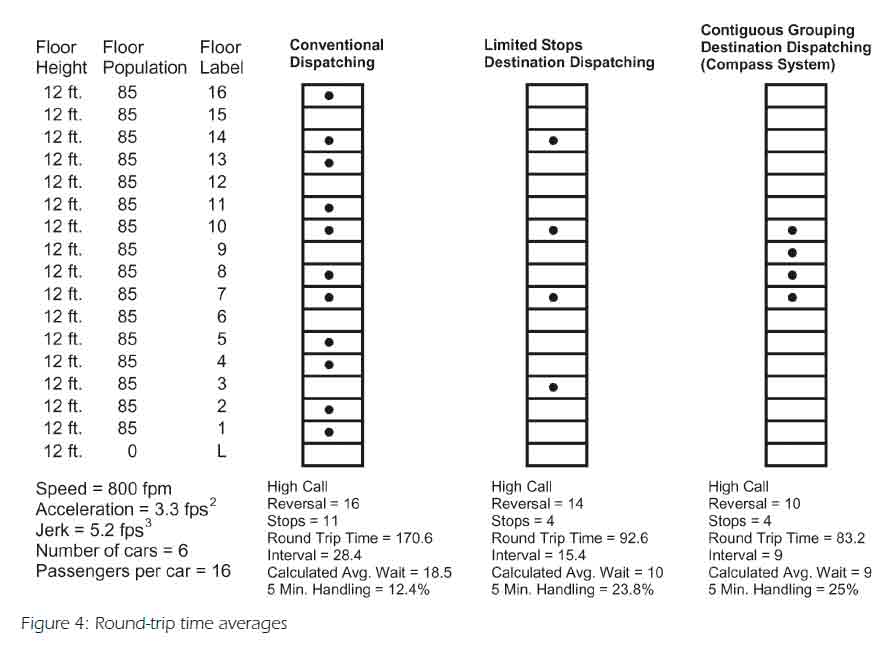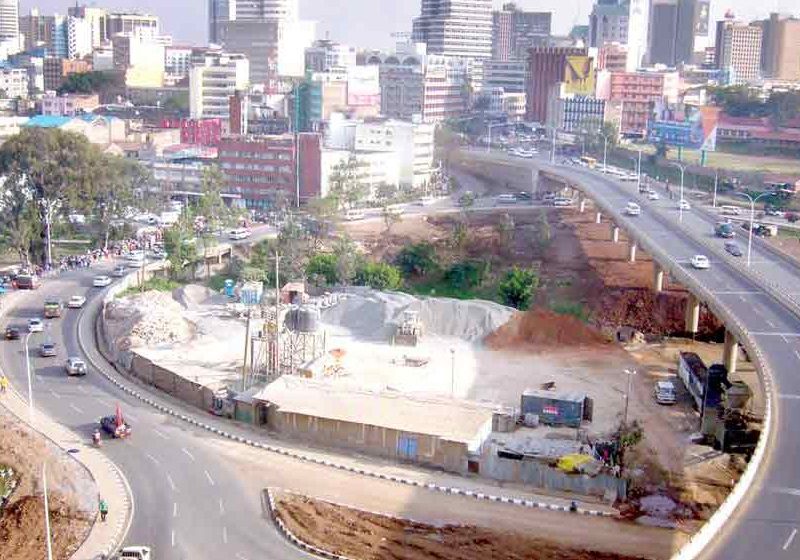The Value of Contiguous Grouping within Destination Dispatching
Mar 1, 2013

Overview
This article briefly illustrates the role of elevator dispatching within an elevator system. It then describes the difference between traditional elevator systems and the destination dispatching approach and explains that destination dispatching directs specific passengers into specific elevators. The article then explores the reasons that contiguous grouping, the grouping of passengers going to contiguous or nearly contiguous floors into the same elevator, provides better elevator service than using non-contiguous grouping.
Elevator Dispatching
In order to most effectively serve the riding public, modern elevator systems use proprietary elevator dispatching algorithms, often referred to collectively as the elevator dispatcher, to determine which car in a group of elevators should respond to a specific demand for service. The dispatcher chooses a particular car to serve a particular request in a way that supports providing the best overall elevator service to all of its users. The dispatcher may consider, among other objectives, how long people wait in the hallway, how long people spend in the elevator and how much energy the system is consuming.
Consider this example: A passenger is waiting for an elevator at floor 3 to take him up to a higher floor in a 12-story building, and there are three elevators capable of serving this passenger. The elevator dispatcher must select which one of the three elevators to assign to this service request. If the first elevator is traveling down to the lobby and is already filled with passengers and the second car is at floor 8 traveling up to drop off two passengers at floors 9 and 10 and the third car is empty at floor 2, then the dispatcher has an easy decision to make – the empty car is probably the best choice.
But the situation is usually more complex than the simple situation described above. Elevator dispatchers must be designed to balance existing known situations (e.g. where is each car currently positioned), existing unknown situations (e.g. how many people are waiting in the hall way for this car) and future unknown situations (e.g. how many people will arrive at floor 10, wanting to travel down, in the next few seconds?) and select the appropriate car that can serve a specific service request in an appropriate amount of time without disrupting overall efficiency of the system. Elevator companies spend significant resources to develop the best dispatching algorithms possible to handle these complicated scenarios.
Elevator dispatchers must provide good service for all passengers. It is not acceptable for an elevator dispatcher to allow some passengers to wait for a very long time while serving other passengers extremely quickly even though this approach might produce acceptable “average” response times. This type of dispatching methodology will result in unhappy long-waiting passengers and complaints of poor elevator service. Instead, dispatchers must balance the requests of all passengers at all locations to make sure that no passenger waits too long or spends too much time in the elevator.
Traditional Elevator Dispatching
Traditional elevator systems work by allowing a prospective elevator passenger to press a button in the hall that signals to the elevator system that the passenger wants to go up or down in the building. Individuals arriving with or after the first passenger who want to travel in the same direction do not need to press the hall button again. The dispatcher assigns an elevator to go to the floor at which the signal was registered and must do so without knowing the passenger’s exact destination.
When the assigned elevator arrives at the floor and opens its doors it also indicates in which direction it will be traveling. All passengers in the hall who want to travel in the indicated direction enter the elevator car. Once the passengers enter the elevator car they indicate their destination floor to the elevator system by pressing a button on the car operating panel located inside the car. If the desired destination has already been registered by someone else, the appropriate button will be lit and there is no need for the newly entered passenger to register it again.
In the traditional approach, the elevator system does not know passengers’ destinations until after the passengers enter the car, and the elevator car must serve all of the destinations entered via its car operating panel during its next trip.
Destination Dispatching
Destination dispatching elevator systems work by allowing a prospective elevator passenger to press a button on a destination entry device (e.g. a keypad or a touchscreen) in the hall that tells the elevator system the passenger’s exact destination. By pressing the “7” button, for example, the passenger tells the system that he or she wants to go to floor 7. Unlike the traditional interface, each person arriving at the elevators must enter their own service request via the destination entry device. The destination dispatcher evaluates the state of the system and determines which car should answer the service request; the selected car is displayed on the destination entry device so that the passenger knows which elevator will serve him or her. Often the passenger will move to stand in front of the assigned car so that he can board promptly when the car arrives.
Use of destination dispatching in an elevator system means that not all waiting passengers in an elevator lobby are waiting for the same car. While one passenger may have been told to use car A, another passenger may have been instructed to wait for car C. Since the elevator system already knows which destinations are assigned to each elevator, passengers do not need to enter their destination once inside the elevator car.
Destination dispatching can offer improved performance in many building and traffic scenarios as compared to traditional dispatching. Improvements are generally due to the dispatcher’s knowledge of where a passenger wants to travel before the passenger enters the car and the dispatcher’s ability to communicate an individual car assignment to each passenger. The quality and type of performance improvements offered by destination dispatching systems compared to traditional systems depends on the skill of the programmed dispatcher in using the additional information and communication abilities.
It is interesting to note that destination dispatching systems must make an immediate car assignment to the passenger. Unlike traditional two-button dispatching systems which have the luxury of making the actual car assignment at the last second, enabling the system to maximize current system knowledge, destination dispatching systems communicate the car assignment to the passenger immediately and cannot subsequently change it without frustrating the passenger. This may, at times, give a performance advantage to the traditional method of elevator dispatching. In general, however, if the dispatching algorithms have been designed appropriately, destination dispatching systems can give comparable or superior elevator performance over an observed period of time.
Passenger Grouping
Passenger grouping is the practice of assigning people traveling to the same floor to the same elevator car, something that cannot be done well in traditional elevator systems because it is difficult to communicate to each passenger which car they should enter. In destination systems, however, the dispatcher recognizes each person’s destination and can direct the passenger to a specific car via a response message on the destination entry device. It is well known that using grouping in up-peak traffic reduces round-trip times, because it reduces the number of stops that an elevator makes after it leaves the lobby. Reductions in round-trip time lead to the desirable effect of decreasing passengers’ waiting times, while increasing the system’s passenger-handling capacity.
Consider the example illustrated in Figure 1. The 17-story building has 85 people on each floor above the lobby and uses four elevators at 800 fpm to transport them to their destinations. In the traditional scenario, illustrated by the left figure, during heavy up from lobby traffic 16 passengers will enter an elevator with its doors open at the lobby. Some of those 16 passengers will go to the same floor, and, using probability theory it can be calculated that, on average, the elevator will make 11 stops and travel as high as floor 16 before it reverses and returns to the lobby. Using grouping, however, people traveling to the same destinations will be directed to the same car. Thus, even though there may still be 16 passengers in an elevator, that elevator, as illustrated by the right figure, will, on average, make only 4 stops and travel as high as floor 14 before reversing direction and returning to the lobby.
Each elevator stop forces the elevator to take time to decelerate, open its doors, wait for passengers to transfer and then to accelerate again as it travels to the next stop. Reducing the number of stops significantly improves the round trip time. In the Figure 1 example building the traditional round-trip time of 170.6 seconds is reduced to 92.6 seconds by using a grouping approach. The five minute handling capacity increases from 12.4% to 23.8%.
The number of different passenger destinations served by an individual car on a given trip depends on the dispatching algorithm. The Otis Compass destination management system, for example, offers a flexible interface that can be configured to use the number of floors in the hoistway divided by a pre-determined number of elevator cars, the percent and quantity of learned traffic, or a fixed maximum to determine the number of different passenger destinations to group in a single car. Other dispatchers may use different approaches.
Contiguous Grouping
The Compass dispatcher not only places passengers traveling to the same destination in the same car, it goes a step further by defining groups such that all passengers in any single car are likely to be traveling to contiguous or nearly-contiguous destinations. Instead of grouping passengers to floors 4, 8, 11 and 15 in a single car, perhaps because the first four passengers using the entry devices requested these floors, for example, the Compass dispatcher recognizes contiguous zones in the hoistway and assigns passengers such that passengers in a specific elevator will be traveling to contiguous or semi-contiguous floors. This approach further reduces round-trip time and increases system handling capacity.
Consider Figure 2, which illustrates that an elevator system can improve its efficiency if, when traveling the same distance, the stops an elevator makes are close to each other instead of significantly separated. This is true because when the stops are close to each other the elevator can travel more of the distance at full speed and spends less time in acceleration and deceleration phases.
Two situations are illustrated in Figure 2. Although the elevator car will travel the same distance to serve both situations, the car spends less time in transit in the Contiguous Stops Scenario than it does in the Equally Spaced Stops scenario. The difference in transit times results from the amount of time that the car spends in acceleration and deceleration phases in each scenario.
It takes an elevator 62.5 ft. to reach full speed with a motion profile of 800 fpm, acceleration of 3.3 fps2 and jerk of 5.2 fps3. In the Contiguous Stops scenario, shown on the left in Figure 2, the elevator reaches full speed of 800 fpm while traveling the 156 ft. from the lobby to floor 13. In the Equally Spread Stops scenario, shown on the right in Figure 2, the elevator never travels more than 60 ft. at any one time and never reaches full speed. In the Equally Spread Stops scenario the traveling car spends all of its travel time in either acceleration or deceleration phases and never achieves the benefits of moving at full speed. The Contiguous Stops scenario car does achieve full speed, resulting in a savings of 2.2 seconds of up transit time.
The Compass dispatcher reduces round-trip time and increases handling capacity by using these natural laws and allocating passenger travel requests via contiguous grouping logic instead of using non-contiguous assignments.
In addition to reducing round-trip time due to shorter up transit times, the Compass dispatcher also benefits from the lowered average high call reversal point that results from contiguous grouping.
Figure 3 illustrates the calculations of an average round-trip time for a contiguously grouped situation. The average is calculated by taking the worst case scenario for each group and averaging over those results. The average high call reversal for a contiguously grouped situation will depend on the applicable group size and number of groups. In the example illustrated in Figure 3, the average high call reversal is at floor 10 meaning that, on average, the elevator car will travel up as high as floor 10 before reversing direction.
Figure 4 compares the round-trip times and handling capacity values for three situations – the traditional dispatching approach, the non-contiguous grouping approach and the contiguous grouping approach for a given scenario. It is easy to see from this example that using contiguous grouping results in the lowest round-trip time and the best handling capacity. The benefits of contiguous grouping in the Compass destination dispatching system result in reduced round trip times which are due to both more time spent at full speed and a reduced average high call reversal floor. The combination of less time in transit and not traveling as far, on average, due to the lower average high call reversal floor increases handling capacity. In the example illustrated in Figure 4, the Compass system’s handling capacity of 25% is better than the handling capacity of either of the other approaches.
Elevator dispatching is a complex situation and contiguous grouping can be used very effectively to produce better performance in many traffic situations. There are times, however, when strict contiguous grouping may not be the best approach to effectively handle the actual traffic scenario observed. The Otis Compass destination dispatching system uses contiguous grouping, based on its proven benefits, but also monitors current and recent traffic conditions in order to determine when to adjust the grouping to include some passenger stops that are not contiguous or nearly contiguous. This flexibility allows the Compass dispatcher to use contiguous grouping in conjunction with non-contiguous grouping to provide optimal system performance.
Get more of Elevator World. Sign up for our free e-newsletter.












